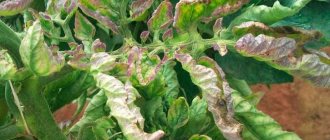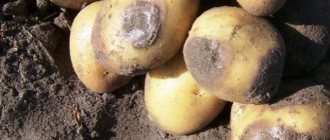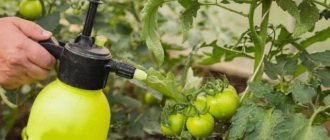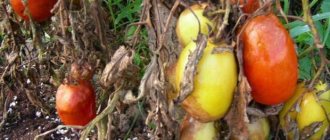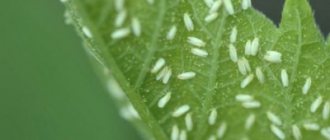Many land owners grow home tomatoes. This juicy, tasty vegetable is very popular with us. Unfortunately, tomatoes are susceptible to a number of diseases. The most common disease is late blight. This is a very serious disease of nightshades, causing large losses of tomatoes grown outdoors and indoors. Find out how to recognize the symptoms of late blight on tomatoes, how to fight the disease, how to prevent its occurrence, what sprays, medications, and folk remedies are recommended.
Description of the disease
First you need to get to know the enemy in order to know how to get rid of him.
Pathogen
Late blight is caused by the fungus-like organism Phytophthora infestans. It is one of the most dangerous pathogens of tomatoes, causing significant or complete crop losses.
Phytophthora is found on potatoes, tomatoes and other nightshade vegetables. In tomatoes, the disease affects all above-ground plant organs, including fruits. Symptoms of rotting on tomatoes grown in open ground are usually observed depending on the weather in late June and early July, when the pathogen en masse infects early potato varieties. However, in tunnels and greenhouses, symptoms on tomatoes often appear in April.
Symptoms
Signs of late blight:
- First, dark green, watery, then brownish spots appear on the leaves, spreading very quickly over the entire surface of the leaf;
- extensive brown necrosis is visible on the tomato stems;
- Gray-green spots are observed on the fruit, then brown spots and rot, the disease spreads deep into the pulp.
On all infected organs of a tomato under conditions of high humidity, most often at the border of healthy and necrotic tissue, a white-gray coating of the late blight pathogen formed by spores appears.
The causative agent of the disease overwinters on plant debris in the form of oospores or in the form of mycelial hyphae, from which, under favorable conditions, late blight spores and sporangia are formed - a source of primary infections.
The course of the disease can be rapid, especially when grown in greenhouses, which leads to complete wilting of tomatoes within a few days.
What late blight looks like on tomatoes - photo
How to distinguish late blight from gray rot of tomatoes?
At the early stage of late blight disease, spots on the leaves can be mistaken for gray rot. In the case of late blight, a white coating appears on the underside of the spots. Tissues affected by gray rot are covered with a gray, dusty coating of conidial spores.
If in doubt, diseased plant material can be sent to a phytopathological laboratory to identify the pathogen.
Conditions for the development of the disease
- The rapid development of late blight is facilitated by high and prolonged air humidity and wet tomato leaves.
- The optimal temperature for the development of the disease is about 21 ºC.
- Temperature fluctuations (more than 25 degrees Celsius during the day, and less than 18 at night).
The most favorable conditions for the spread of late blight combine 2 factors simultaneously:
- two days during which the temperature (even at night) does not fall below 10 ºC;
- relative humidity of 89% or more for at least 11 hours.
In practice, such conditions can occur throughout the summer (more likely in late summer), especially when rain falls after hot summer days, but the air does not cool.
How to spray tomatoes in open ground?
Experts do not recommend using folk remedies against late blight for tomatoes in open ground, using vinegar, brilliant green, iodine and potassium permanganate. The sun's rays in combination with these substances can harm the plant, they can get burned and subsequently die.
It is worth knowing that you need to re-treat the plant if it rains immediately after spraying.
On open ground, it is better to use solutions made from salt, tinder fungus, whey or garlic. To ensure that the substances that fight late blight are fixed on the leaves, add grated laundry soap to the solution.
Prevention
Effective control of late blight on tomatoes requires taking preventive measures and avoiding conditions that promote the development of the disease.
Tomatoes should be systematically monitored during the growing season at intervals of 5-7 days. During dangerous periods (high humidity and precipitation), plant inspections are carried out every 2-3 days.
Interventions are applied immediately when symptoms of the disease appear.
Methods for preventing late blight:
- Avoid growing tomatoes in close proximity to potato fields (P. infestans infects plants from the nightshade family).
- High plant density should be avoided. The denser the tomatoes grow, the less sunlight reaches the plants, the more humidity is created - ideal conditions for the development of fungal diseases. For the same reason, it is recommended to thin out tomatoes.
- Tomatoes cannot grow in too high a density; the leaves of individual bushes should not touch each other.
- Don't let tomatoes lie on the ground. Cover the soil around the bushes with non-woven material, black agrotextiles, and straw. Black agrotextiles accelerate the ripening of tomatoes and retain moisture in the soil. You can place boxes under the fruits.
- It is recommended to remove the lower leaves of tomatoes when the fruits on the lowest branches ripen - on mature plants it is worth removing the lower leaves, leaving about 20 cm from the base of the bare stem. Germinated spores are often found in the ground; at the time of watering, the soil “splashes” onto the lower leaves, which leads to the occurrence of the disease. To get an even better protective effect, the soil around the tomato bushes can be mulched.
- You should regularly remove small shoots of tomatoes growing from the corners of the leaves - stepsons (they are not needed - they weaken the harvest and cause excessive thickening).
- Tall varieties of tomatoes form 2-3 stems. The lower density of the plant allows air to circulate.
- Crops should not be placed in depressions, near bodies of water, where high humidity prevails and accumulated fogs contribute to the infection of tomatoes.
- Producing healthy, pathogen-free tomato seedlings.
- Compliance with crop rotation - in subsequent years, tomatoes should be planted in different places than in the previous one; tomatoes should not be planted after tomatoes or potatoes.
- Careful removal of infected plants and plant debris after the end of the growing season.
- Prevention of late blight on tomatoes in greenhouses and greenhouses includes regular decontamination or replacement of the soil.
- Application of fertilizers with a high content of calcium and one of the most important microelements for tomatoes - boron.
- You cannot overdo it with the use of nitrogen fertilizers - in excess they are unfavorable for both the plant and the substrate - they cause salinization.
- When growing tomatoes indoors, it is extremely important to regularly ventilate greenhouses and plastic tunnels so that the air inside is not excessively humid.
- You need to water the tomatoes carefully, without spraying the leaves, pour the water directly onto the soil.
- Maintain hygiene - when removing infected parts of the bush, be careful not to touch healthy plants; tools should be washed thoroughly.
- Apply copper-based fungicides before expected long-term precipitation events, especially when it is very hot.
It is important to choose varieties that are least susceptible to disease.
Tomato varieties resistant to late blight:
- Resistant varieties: Fantasio F1, Dubok, Ogorodnik, Perseus, Gypsy, Yuhas, Akademik Sakharov, Promik, Resonance, Velmozha, Orange Miracle, Grandmother's Secret.
- Tolerant varieties: Tatyana, Lancet, Cardinal, Atoll, De-barao.
- Moderately tolerant varieties: Cerrola F1.
Sometimes, even if you follow all the above tips, late blight will still attack your tomatoes. This scenario has been repeated many times by many gardeners. Therefore, the most important advice for preventing late blight.
Spray the ground around the tomatoes with a solution of copper (II) sulfate. This is copper sulfate, its chemical formula is CuSO4 + 5H2O.
Late blight spores can sit in the ground and wait for favorable conditions to develop. If the disease has already attacked the plants in previous years, rain will wash the spores off the plants and the soil will become infected. Therefore, it is always important to cultivate the soil after late blight in the fall to prepare it for planting and protect new plants.
Copper sulfate is a good, proven remedy for late blight. In addition, branded copper fungicides are quite expensive, and when tomato plantings are large, treatments are quite expensive. One kilogram of blue copper sulfate costs from 350 rubles, which is very cheap compared to fungicides, especially imported ones!
How to prepare a solution for spraying tomatoes against late blight from copper sulfate?
Dosage. To prepare the solution, dissolve 1 teaspoon of copper sulfate (about 5 g) in 1 liter of water.
It is easy to calculate that from 1 kg of copper sulfate you can prepare 200 liters of solution! This will be enough for the whole season.
Note: Copper sulfate (copper sulfate), although very attractive, is toxic. When working with it, take all precautions and wear protective clothing!
Types of late blight
Known species include:
- Phytophthora infestans Mont de Bary. It affects potatoes and other nightshades and is active between May and August;
- Phytophthora fragariae Hick. There are two forms (var. Rubi, var. Fragariae). Microorganisms of this type can destroy the harvest of raspberries, strawberries and buckwheat;
- Phytophthora cactorum Schroet. Symptoms indicating infection occur on trees from families such as rose hips and beech.
If you know how to deal with this disease, you can save your harvest from this disease.
Read the article about potato late blight.
Struggle
Due to the rapid development of the disease and the great damage it causes, spraying is carried out preventatively before symptoms appear on tomatoes. The signal for mandatory preventive spraying is the appearance of symptoms on nearby potato crops. The choice of how to treat tomatoes against late blight should take into account the prevalence of the disease.
Traditional methods
If we avoid using chemical protection on the site, for preventive spraying against late blight, it is worth using traditional methods. It should be understood that the effectiveness of folk remedies for late blight on tomatoes is much lower than that of chemicals.
Important! Liquid solutions should be prepared in plastic buckets, not metal ones.
Spraying with horsetail infusion
Horsetail (Equisetum arvense) contains potassium, phosphorus, iron and manganese, as well as a lot of silicic acid, which prevents the formation of fungal diseases. Therefore, it is worth regularly using ecological spraying of tomatoes with horsetail decoction.
Pour 500 g of green leaves (or 100 g of dried horsetail) with 5 liters of water and wait for the end of fermentation. Use a solution diluted with water in a ratio of 1:5. Horsetail infusion contains a large amount of silicic acid, which prevents the development of fungi such as powdery mildew and late blight, and also repels aphids.
Nettle decoction
Nettle decoction can be used prophylactically against late blight on tomatoes. The solution is prepared with 0.5 kg of fresh plants and 5 liters of water. The broth is boiled for 0.5 hours. After cooling, the diluted preparation is diluted with water in a ratio of 1:5, watered and sprayed on the trusses of endangered tomatoes. Most often, the decoction is used in early spring.
Spraying with yeast
The most commonly recommended natural method against late blight is spraying your tomatoes with yeast. To prepare the solution, you need to take a cube of baker's yeast (100 g) and dissolve it in 10 liters of water. Some people add half a liter of milk. Tomatoes should be sprayed against late blight at intervals of 7 days.
Spraying with milk
Another recommended natural method is to spray your tomatoes with milk. Milk should be diluted with water in a ratio of 1:5 and sprayed regularly every week.
It should be remembered that the effectiveness of such natural sprays against potato rot on tomatoes is low, although many organic gardeners highly value them. The methods work to prevent disease.
Garlic for treating fungus
Using natural products like garlic spray is beneficial and safe for plants, people and the environment. Therefore, it is worth protecting tomatoes from late blight using garlic preparations. Learn how to make a garlic spray to keep your vegetables healthy.
Attention! Remember to thoroughly spray the top and bottom sides of the tomato leaves.
The effect of garlic in protecting tomatoes is based on its bactericidal and fungicidal properties. The characteristic smell of garlic also repels pests. Garlic preparations have been used for many generations, especially in home gardens where tomatoes are grown on a small scale.
Garlic extracts and decoctions help fight aphids, spider mites, whiteflies, and prevent some bacterial and fungal diseases. Spraying tomatoes with garlic for prevention should be done regularly, preferably every week, and also in case of infection.
Garlic extract
Preparation:
- garlic cloves (about 200 g), grate or chop;
- pour 10 liters of water and leave for 24 hours;
- strain through a fine sieve;
- Pour the prepared extract into a sprayer and spray.
Attention! The extract cannot be left for later, it loses its properties. It is used immediately after preparation.
Garlic decoction for spraying tomatoes
Preparation:
- grind garlic (about 200 g);
- pour 10 liters of water and leave for 24 hours;
- cook the broth for 20 minutes;
- let cool and strain through a fine sieve;
- Pour the drug into the sprayer and spray.
It's worth knowing! Decoctions have a longer lifespan than extracts. They can be stored for about 2 months in a shady place in a closed container. If you need to store the broth, pour it into jars while still hot, close and place upside down.
Good advice! A small amount of potassium soap, commonly used in gardening, can be added to prepared extracts and infusions. Such solutions adhere better to the leaves and shoots of plants.
Liquid garlic fertilizer for watering tomatoes
In addition to garlic extract and decoction, it is worth preparing garlic fertilizer used for watering plants.
Diluted garlic fertilizer in a ratio of 1:10 strengthens the plant and prevents the development of fungal diseases and pest attacks. Prepare the mixture in a plastic container placed in a shaded place. The container is covered, but not tightly, preferably with gauze. Preparation time 2-4 weeks. After a week, a small amount of foam forms on the surface, which is a sign that the fertilizer is beginning to ferment. After 2-3 days, stir the mixture. The fertilizer is ready for use when a new layer of foam no longer forms. It should be brown in color.
The fertilizer is used only in soil fertilizing from the 2nd week after planting tomatoes, preferably once a week until the tomato fruits ripen.
Leaves must not be sprayed!
Preparation:
- garlic cloves (100 g);
- or fresh garlic leaves (500 g);
- dry garlic leaves and husks (200 g).
Crumble everything and add 10 liters of water, leave for 2-4 weeks to ferment. Dilute in a ratio of 1:10 and strain.
Furacilin
Some gardeners use furatsilin treatment against late blight on tomatoes. To prepare the solution, 10 furatsilin tablets are dissolved in 1 bucket of water with a capacity of 10 liters. The resulting solution is used to treat tomato bushes before flowering and at the ovary stage.
Iodine and boric acid
Another folk remedy for combating tomato late blight is a solution of iodine and boric acid. To prepare the solution, take 1 teaspoon of 1% boric acid and 30 drops of iodine per 10 liters of water. Tomatoes are processed in the morning before the bees arrive. During the day, when it is hot, it is impossible to treat tomatoes; in the evening it is undesirable.
Preventive baking soda spray
It is worth spraying purified soda regularly - about 1 teaspoon per 1 liter of water. Baking soda changes the pH of the leaves, creating an environment unfavorable for fungal diseases. Spraying must be repeated every 2 weeks and after each rain.
Soda is sprayed only in the morning, preferably on cloudy days. When plants are sprayed during the day, the leaves are exposed to the sun - increasing the risk of sunburn. In the evening there is already more humidity, if you add spraying to this, this provokes fungal diseases.
Chemical protection products
Spraying with fungicides should be carried out on the entire tomato: leaves, stem, fruit.
You need to be careful not to pick or eat tomatoes immediately after spraying. Manufacturers usually indicate a period for late blight preparations during which processed vegetables should not be eaten. As a rule, this is 3-7 days.
To completely get rid of late blight, a single spray is usually not enough. Spraying should be repeated within two weeks, preferably 12-14 days after the first spraying.
Special fungicides are used in chemical protection.
- Acrobat MTs 69 VG. The drug is suitable for combating late blight on ground-ground tomatoes and in greenhouses. The dosage in open ground is 25 g of the product dissolved in 7-8 liters of water, which is enough to grow tomatoes on 100 m². When grown in greenhouses, a concentration of 0.3% is used, i.e. 30 g of the drug is dissolved in 10 liters of water.
- Polyram (Polyram 70 WG) - a fungicide is used only on tomatoes grown in open ground at a dose of 12-18 g, dissolved in 6-7 liters of water. This amount can be used to treat hundreds of tomato plantings. The drug also fights Alternaria. Can be used up to 3 times a season, repeating spraying every 7-10 days, alternating with fungicides from other groups.
- Ridomil Gold (Ridomil Gold MZ Pepite 67.8 WG) - a fungicide used against late blight and alternaria on tomatoes in open ground. The dose is 22.5 g, dissolved in 6-8 liters of water, which is enough to spray 100 m² of plantings. The first spraying with Ridomil is carried out prophylactically at the 5-leaf stage. During the season, a maximum of 3 sprayings can be carried out every 7-10 days. Use alternately with other fungicides.
- Revus (Revus 250 SC) - a fungicide used against late blight and alternaria on tomatoes in open ground. The dose is 6 ml per 4 liters of water, which is enough to spray 100 m² of crop. The first spraying is preventive, carried out when there is a threat of disease or after the first symptoms appear from April to October. During the season, a maximum of 3 treatments can be carried out every 7-10 days. Use alternately with other fungicides.
- Amistar (Amistar 250 SC) - used in open ground for growing tomatoes in a dose of 8-10 ml of the product dissolved in 8 liters of water per 100 m².
- Amistar Opti 480 SC is a double preparation for growing tomatoes in greenhouses. Dissolve 25 ml of product in 10 liters of water, which is enough for 100 m². Apply 2 sprays per season with an interval of 14 days.
- Cabrio Duo 112 EC is a universal product that, in addition to potato rot on tomatoes, also fights early rot and anthracnose. Can be used prophylactically or during the onset of the first symptoms of the disease, but no more than 3 times per season, maintaining a gap of 7-10 days between courses of treatment. Dosage: 20-25 ml of product per 2-10 liters of water.
- Miedzian 50 WP is the main agent for use on amateur crops in household plots. Fights against many bacterial and fungal diseases on various crops, including bacterial rot and late blight on tomatoes. Can be used prophylactically before late blight symptoms appear, during periods of expected threat of disease. When growing tomatoes in Miedzian 50 WP soil, use 25-30 g of the product diluted in 7 liters of water, which allows you to spray 100 m² of tomato beds. For tomatoes in a greenhouse, 30 g of the drug is added to 10 liters of water. You can perform 2-3 sprays every 7-10 days, preferably alternating with fungicides from other groups.
- Fungicide Signum (Signum 33 WG) - spray for prevention (especially when cultivating the soil, when the first symptoms of late blight appear on early varieties of tomatoes growing in the area or when the first symptoms of the disease appear. Repeat spraying with Signum every 7-10 days, up to 3 times per season Use 2 g of product per liter of water.
The list of funds is much longer. However, not all are suitable for amateur cultivation in plots. Regardless of the product you choose, remember the general rules:
- Spraying should begin before the first signs of the disease appear;
- repeat spraying every 7-10 days, alternating different preparations (at least 2);
- Most of these drugs should not be used more than 2-3 times per season.
If the disease is at a late stage, all that remains is to dig up and burn the affected plants.
Attention! Sick plants should not be placed in a compost pit.
Reviews from gardeners
Many gardeners use substances on hand to treat fungal diseases on tomatoes.
- Video blogger Tatyana, who runs her “Harvest Garden” channel on YouTube, resorts to folk remedies for the prevention and treatment of late blight. She takes one tablespoon of hydrogen peroxide per 10 liters of water and sprays the plants with this solution.
- Video blogger Valery, creator of the channel “Garden, vegetable garden with your own hands,” places iodine bubbles in his greenhouse to combat late blight. Gradually, iodine evaporates and gives an antibacterial effect, so fungal disease can be avoided.
Drug release form
Each summer resident independently selects what type of preparation to use to treat the area. The following types can be used against late blight:
- Liquid. Easily dissolves in water and has universal use.
- Granules and powder. Before preparing the solution, the dry substance must be dissolved in a small amount of water and only then diluted in accordance with the instructions.
- Paste. For a long time it retains all its beneficial properties for plants even after preparing the solution.
In order to get the maximum benefit from the drugs, experts recommend carrying out several treatments. However, the period between treatments must be at least 15 days.
How to treat a greenhouse against late blight
All agrochemicals and pesticides used in agriculture are listed in the State Catalog. To get rid of late blight, you will need drugs such as:
- Consento – fenamidone, propamocarb hydrochloride;
- Sectin Phenomenon – mancozeb, fenamidone;
- Previkur Energy – fosetyl, propamocarb;
- Thanos – cymoxanil, famoxadone.
Khom is especially popular among summer residents. This fungicide includes copper oxychloride.
Many people use Furacilin, Metronidazole and Trichopolum as a remedy. Among pesticides, Fitosporin is the leader. It can be combined with other drugs. Ordan is a hazard class 3 fungicide. The frequency of use is determined by the duration of the therapeutic effect. The solution is prepared according to the attached instructions.
You can also use potassium permanganate, calcium chloride, brilliant green, boric acid, Bordeaux mixture, copper sulfate and calcium nitrate.
Causes of late blight
Late blight is transmitted from a diseased plant to a healthy one through direct contact, through the soil and by wind. Harmful spores are spread throughout the entire area, “traveling” on the soles of the gardener. Don't forget about pets and insects. They can also become carriers of infection.
The pathogen is capable of living in the soil cover for several years. In this case, its activation will occur when suitable conditions occur. You can get rid of the disease using chemicals and traditional methods.
